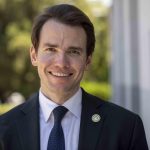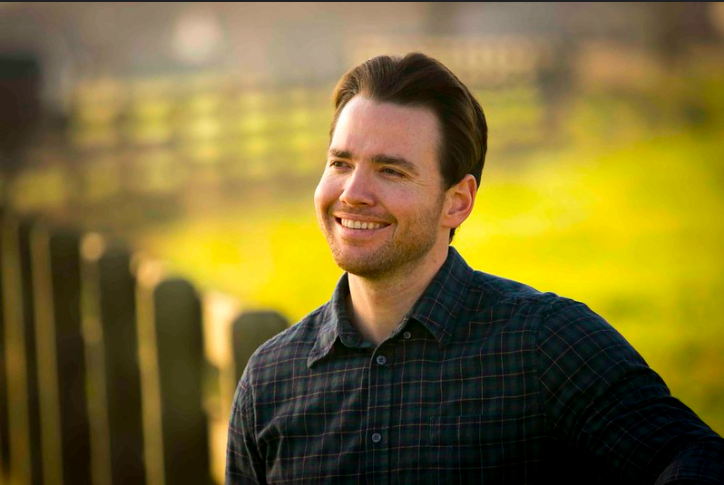
Governor Gavin Newsom. (Photo: Kevin Sanders for California Globe)
What the Recall Candidates are Saying About Infrastructure
If you don’t build it, they will leave
By Thomas Buckley, August 30, 2021 2:31 am
There is a saying in California politics (popularized by Willie Brown) that, when it comes to big projects, one should just “start digging a hole and make it so big, there’s no alternative to coming up with the money to fill it in.”
It is ironic, then, that no matter how much money California voters dedicate to major infrastructure projects that the state has not even dug a hole to put water in for decades. It clearly hasn’t been an issue of funding; it just clearly been an issue of Sacramento.
Bond and other funds totaling in the billions have been allocated, approved, signed, sealed, and delivered for water, power, and transportation infrastructure projects that, except for the impending linear Stonehenge being built between Bakersfield to Merced, simply never actually even kind of happen.
From the Sites Reservoir project, to the Temperance Flats water storage project, to recycled water projects, to raising the Shasta Dam, projects are touted then trimmed, shelved, or abandoned for any number of reasons.
Usually those reasons involve NIMBYism or actual environmental complaints or technical glitches, or minor environmental complaints or egregious oversight or delusional environmental complaints or poor planning or utterly fictional environmental complaints – whatever the cause, it doesn’t seem to matter how much money you have to fill in the hole if you can’t even dig one in the first place.
To that end, this week’s questions in our recall candidate issue “round up” series are about infrastructure.
Q1 – Despite the billions of dollars in bond money that has been dedicated to improving the state’s problematic water, road, and power systems, actual completed projects to keep up with the needs of California are few and far between. Why do you believe the state has failed to meet its publicly promised targets?
Q2 – As governor, what projects would you prioritize to improve California’s infrastructure and what projects – such as high-speed rail – would you end and why?

Joel Ventresca:
Q1 – Half of my professional career at the San Francisco International Airport was managing building infrastructure improvements. Building infrastructure projects on time and under budget was the norm for projects I was involved with at the airport. The state has not met its publicly promised targets because of failed leadership and failed management. I will change that as the next new Democratic governor of California.
Q2 – I will build new infrastructure to: reinvent California into the first zero-carbon emissions state in the nation, restructure energy utilities into a full-service consumer-owned statewide public power system that operates efficiently, reliably, sustainably, and safely with 15% lower rates, and convert to non-nuclear 100% clean renewable energy.
I will work to get people out of plane seats and into high-speed train seats between our major cities. I will work to get people out of cars and into free public transit in our cities.
I will conduct a comprehensive audit to see if any infrastructure projects should be cancelled. However, I support high-speed rail between our major cities.

Ted Gaines:
Q1 – California is a crumbling, unprepared state. Leftist leadership has spent decades indulging fringe environmental positions that have driven up all construction costs and made it nearly impossible to build anything anywhere.
We are in an infrastructure crisis now and it’s getting worse. We haven’t built a new state water storage project for 40 years, even though the state’s population has doubled in that time. Water shortages continue to threaten our farmers, who find themselves below the Delta Smelt in the water pecking order. We don’t need more money to fix this problem, we need more political will. Sites Reservoir should have been completed already. The fact that the money from the 2014 water bond hasn’t led to any new storage is criminal.
We are about to close down Diablo Canyon nuclear power plant and throw our already strained power system into chaos. That is a political choice. That power will simply not be replaced by wind and solar, and citizens will see higher prices and more blackouts if we continue on that path.
Our renewable-dependent power grids are already overburdened, and blackouts are common. Those blackouts are also a political choice.
California’s Progressive vision is heavy on promises and low on practicality. Its publicly proclaimed targets are utopian fantasy and should not be taken seriously. California should deliver affordable abundance for our citizens.
Q2 – As governor, I will cancel California’s High-Speed Failure on day one. It’s hard to overstate how fruitless this endeavor has been; never before have so many, paid so much, for so little. This project failed every test of good governance when it passed out of the legislature to the ballot and has only gotten worse from there.
My first priority must be the approval and building of water storage projects. It’s been seven years since the voters approved Prop. 1 to increase our water storage, and here we are today without a single gallon of new water storage built. As governor, I will expedite these pending projects, like the Sites Reservoir, by nixing unnecessary environmental regulations and ensuring that these projects get enough bond money for completion.
Next, we will take on an aggressive forest management campaign to reduce our susceptibility to wildfires. We have spent too many years turning California into a tinderbox, and we cannot simply wait for wildfires to burn the fuel away along with our communities. This must be tackled head on through extensive manual thinning and a revival of our lumber industry. By promoting public-private partnerships and allowing logging to resume on public land, we can greatly reduce our vulnerability while simultaneously bringing back good jobs and stimulating our economy.
It’s also essential that we look beyond renewable energy to keep our lights on and our refrigerators working. That means keeping Diablo Canyon nuclear plant open and expanding other nuclear and fossil fuel opportunities. This state and our nation are gifted with incredible fuel resources, and we need to be willing to explore every option to ensure that our energy grids are reliable and affordable to all Californians.

John Cox:
Q1 – California politicians and government are terrible at project management because they are all about politics, not getting the job done. The reason they haven’t spent the water bond money is that there are noisy interest groups who demand their needs get met. Meanwhile, problems get worse. They are great at raising taxes and issuing debt, but not good at managing it and using it wisely and efficiently. As a CPA and businessman, I’ve spent my entire career stretching a dollar and making sure building projects are delivered on time and on budget. We need to bring that kind of management to state government by bringing in private sector experts who care about getting things done efficiently and on time.
Q2 – We have to prioritize projects based on cost and impact. We need to spend money efficiently and productively. We need to assess the benefits of doing things against the risk of not acting. This is an everyday occurrence and commonsense in business, but rarely done in politics. That’s why we wind up with multi-billion dollar boondoggles like the high-speed rail project, as people sit idling in traffic. As governor, I’d cancel the high-speed rail project, saving billions of dollars. I’d focus on critical infrastructure and on road projects that would alleviate congestion. We want Californians to be able to get where they are going quickly and efficiently. I’d also focus on acquiring jets to serve as tankers to attack these fires with overwhelming force of fire suppressants. I’d focus on desalination, recycling and storage projects to assure we have enough water. I’d focus on energy generation with nuclear, natural gas and hydroelectric power to go with the already massive investment we have made in solar and wind.

Kevin Kiley:
Q1 – California’s recurring water shortages are entirely avoidable. But we have failed to invest in the storage and infrastructure that would allow us to save water in wet years that could be used in dry years.
My plan would allocate a percentage of the state’s general fund for construction projects – dams, aquifer storage, conveyances, desalination, potable reuse of wastewater, and water treatment – to increase the annual sustainable supply of water to California’s cities and farms by several million acre-feet. It would also require state agencies to spend the money as intended and safeguard projects against excessive litigation and liability.
Q2 – In the short term, it is critical that our state eliminate the red tape and litigation traps that are stopping construction of projects like Sites Reservoir and Temperance Flat. While I also support putting an end to the hundreds of millions being spent on failed projects like the high-speed Rail, I believe we need a dedicated annual funding source for water projects in the state budget.
Rather than taking action, Newsom has simply surrendered to “Mother Nature” with severe water cutbacks. My plan would end the era of shorter showers and fallow fields.

Michael Loebs:
Q1 – California’s population has doubled since 1970 and infrastructure development has by and large failed to keep up. Part of this is attributable to poor planning by previous administrations, and even
now we are recovering from the “deferred maintenance” on important infrastructure projects of earlier decades. However, much of it is also due to unrealistic presentations to the voters about costs, timelines, and goals. I do not by any means object to large, publicly funded infrastructure projects at a statewide level, but too often voters are not given accurate information about the true scale of
these undertakings. Projects are begun without clear plans, with an often unreasonable optimism that solutions not yet possible will simply present themselves in time. Until politicians are honest with
California’s citizens with realistic assessments of development, California will fail to meet its infrastructure development goals.
Q2 – The government must stop supporting the monopoly of PG&E over 2/3rds of California, whose focus on shareholder profit over the safety of Californians has been responsible for many of the most destructive wildfires in recent history. California should oversee the transmission grid as it does the major roadways that span multiple counties, as well as update the distribution grid which it would then
transfer to local and regional electrical utilities. Such regional power companies could be public utilities, private corporation, or any configuration desired by the local consumers.
High speed internet access needs to be expanded into rural California, as the last year’s requirements for online teaching has made clear. High-speed rail was an important idea done badly, an instance of building without a clear idea of how to make it actually work, promising too much too soon.
However, a replacement for more environmentally destructive short-distance air travel to efficiently connect the Central Valley, and Southern California will soon be necessary. A high-speed train line from Sacramento to Bakersfield was always the most straight-forward and cost-effective route to initially construct, and facilitating passenger transit in one of California’s fastest growing regions would be no small feat. More expensive and construction intensive connections to the Bay Area and Los Angeles would occur later, with greater emphasis on encouraging public-private partnership in the construction. This, in practice, is what is occurring, and should have been presented honestly to California people, not filled with impossible expectations.

Larry Elder:
Q1 – California sits on an $80 billion budget surplus yet forest fires continue to ravage our precious lands, power outages are common, and water is scarce. If any private company had such mismanagement the CEO would have been fired long ago! Gavin Newsom is more concerned with appeasing his donors and private interest groups than he is with fixing California’s failing infrastructure.
Some 4.3 million acres burned in 2020. That is the most ever in California’s history. Newsom admits that our forests need brush clearance and improved management. But he cut funding and scaled back fire-prevention work. He is seemingly focused solely on proving that climate change is responsible for fires, that he is blinded to commonsense solutions to stop the carnage.
A recent damning report by California’s State Auditor, Elaine M. Howle proves further gross mismanagement. Among other things, she reports serious concerns about California’s “ability to maintain reliable access to water.” This is outrageous!
Q2 – Our current leadership is asleep at the wheel—prioritizing bullet trains while our most popular infrastructure crumbles. As governor, I would end government support for high-speed rail and focus on what really needs attention.
I will protect our forests. Not only will I allocate adequate resources to firefighting and prevention—especially during drought years—I will also ensure proper and responsible care for the Sierras through a combined effort with the feds.
As for our current water needs, all options should be on the table: desalination, reforming regulatory barriers in water trading, and a functional pricing system so that markets can properly allocate resources to those most in need. But most importantly I will be upgrading our water system. Our current system was built to support a population half the size of what California has today. It is not rocket science to understand that this is unsustainable.
As governor, I will be able to walk and chew gum at the same time. We can be smart about environmental concerns while not causing an undue burden on our state’s energy production. High energy prices are a hidden tax on poor people and folks on fixed incomes.
If Newsom cared even half as much about the average Californian as he does about his special interest groups, we’d see quick infrastructure improvements. Cronyism is always bad public policy.

Jenny Rae Le Roux:
Q1 – Incompetent leaders, corruption, and bureaucracy are to blame. For example, money from Prop 1, which allocated $7.5B towards water storage and was approved by voters in 2014, has yet to be used to even break ground on one water infrastructure project – all while California families and farmers are asked to sacrifice running water. This is incompetent leadership at best, and outright dereliction of duty at worst.
Specifically, the environmental permitting process is taking too long when it comes to approving water, energy, and transportation infrastructure. How is it that a new basketball arena in Inglewood can receive approval in less than 2 years, and stadiums in Sacramento and San Francisco can receive approvals in 5 years, yet critical water infrastructure (paid for by Prop 1) is still in the approval process 7 years after the funds were made available?
It’s time for new leadership in California; I am running to free the state from this incompetent administration and to refocus state government on the issues that really matter.
Q2 – Environmental management matters deeply to me; water and air are precious shared resources. Yet current environmental policy has serious drawbacks.
Water – I will urgently complete new water storage; California has not completed a major water infrastructure project since the 1970s. I will also prioritize replacing conveyance infrastructure; California loses over 8 billion gallons of water per year to leaking pipes. In addition, I will accelerate permitting for additional water treatment and desalination plants in major cities to boost water supply in coastal areas. Finally, I will turn on the Delta pump to stop millions of gallons of water from being flushed out to the Pacific Ocean.
Energy – We need consistent, flexible, and affordable power supply that reduces dependence on foreign oil. I will retain hydroelectric power sources and invest in our natural gas production – which is safe, cheap, and clean. I will reverse the shutdown of California’s last nuclear power plant – which provides almost 10% of California’s energy.
Transport – I will end the boondoggle that is the high-speed rail project. We’re spending $1.5B per year on a project that hasn’t even completed Phase 1 thirteen years after it was approved. Instead, I will prioritize repaving California’s 26,000 miles of freeways and highways, as well as expanding roads in heavily populated areas to ease congestion.

Kevin Paffrath:
Q1 – The state has a failure of leadership. With strong leadership, we can work with the legislature in probably streamlining processes to ensure funds like rental relief and EDD money don’t fall through the cracks of fraud, but instead are promptly allocated to bold projects that will help propel California towards financial success, rather than bankruptcy.
Q2 – We’d end the 71-year-breakeven project such as the high-speed rail and instead reallocate that over $100 billion to Future Schools, where folks can learn a financial education and get a career within 2 years. These schools will be available for high schoolers starting at 16 by choice and separately for adults. Adults will earn $2000 per month to go to Future Schools to finally break the cycle of poverty, crime, and homelessness, so that folks can graduate with dignity, a career, startup capital, and financial education.

Kevin Faulconer:
Q1 – There’s a lack of leadership from the state for meeting our infrastructure needs. Key projects are endlessly held up in red-tape and bureaucracy. There is no better example of this failure than water infrastructure. Voters were promised new storage when they passed the 2014 water bond, yet they have little to show for it as this drought hit the state.
Q2 – I would end high speed rail and redirect the funding to more critical projects like road construction and water storage. High speed rail is hopelessly over-budget and is distracting us from the meeting the real needs of Californians. That money would be much better spent improving traffic and preparing for the next drought.
Per usual, we asked some of the folks behind the recall effort itself how they felt the state’s infrastructure issues contributed to the successful signature gathering effort and to the campaign so far. Here’s what Mike Netter of www.recallgavin2020.com had to say:
Q1 – How much of a role did the state’s crumbling infrastructure play in the effort to qualify the recall for the ballot?
The condition of the roads is a major factor in the drive to recall Gavin Newsom. The challenge that people have every day is just getting around while paying the highest gas tax in the country – that affects the everyday Californian. Add to the fact the water and sewage lines throughout the state are left for counties and cities to fix with no help from the state surplus, so imagine how people feel when money is just handed out to non-citizens who are unemployed why their car is hitting potholes. Imagine the optics of driving on freeways and streets that are so unpaved they take the pride away from the community. Constantly Californians are told how bad our infrastructure is. Yet consistently the State has not developed a plan even as they try to push more housing density on overtaxed systems that can barely handle the population that resides there now. This is what people see and experience every day. Lack of pride in California is a major reason people move and are voting yes.
Q2 – Do you think the obvious failure of mega-projects – specifically high-speed rail – will impact how Californians vote on the recall?
Imagine how ridiculous it is that the State with all its problems continues to push forward with a bullet train that costs billions and even if completed will serve very little purpose to a small amount of the population . Gavin could have been a hero if he had kept his stance on this and stopped it as he said he would when he entered into office. Instead he has caved to the unions for which it is a “make work” contract. This issue gets lost in the shuffle with all the problems Gavin and created and with all the problems we have. The 30 billion spent on this could be used in so many other places and solve so many other issues – Why wasn’t an executive order used to suspend or terminate this? This again is something well publicized and will bring in many yes votes as it may be one of the largest pork projects in history.
And also, as per usual, the Newsom campaign was sent a pair of questions which they, as per usual, declined to answer (just in case you’re wondering, I know they’re getting the emails). Anyway, here is what they could have replied to instead of making sure the inexplicably Elizabeth Warren-centered TV spot got into heavy rotation:
Q1 – State voters have authorized billions of dollars in additional bond money for infrastructure improvements that do not seem to have actually occurred. Why is it so difficult to complete any major project and should you have focused more on the infrastructure issue?
Q2 – If you remain governor, what will you do to improve the state’s infrastructure and, specifically, will you continue to support high-speed rail?
- Benefit Fraud Problems and Solutions - November 7, 2024
- A Little Exit Poll - November 5, 2024
- Tomorrow’s Headlines Today! - November 5, 2024





One thought on “What the Recall Candidates are Saying About Infrastructure”